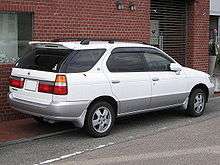Nissan R'nessa
The Nissan R'nessa is a station wagon manufactured by Nissan from 1997 to 2001. According to Nissan, the name derives from "packaging renaissance for versatile, spacious comfort on wheels."
| Nissan R'nessa | |
|---|---|
 | |
| Overview | |
| Manufacturer | Nissan |
| Also called | Nissan Avenir export |
| Production | 1997 - 2001 |
| Body and chassis | |
| Body style | 5-door CUV |
| Layout | FWD / AWD |
| Related | Nissan Cefiro Nissan Presage Nissan Bassara |
| Powertrain | |
| Engine | 2.0 L SR20DET turbo I4 2.0 L SR20DE I4 2.4 L KA24DE I4 |
| Transmission | Hyper CVT 4 speed automatic (E-ATX) 4 speed automatic (E-AT) |
| Dimensions | |
| Wheelbase | 2,800 mm (110.2 in) |
| Length | 4,680 mm (184.3 in) |
| Width | 1,765 mm (69.5 in) |
| Height | 1,690 mm (66.5 in) |
| Curb weight | 1,640 kg (3,620 lb) |
| Chronology | |
| Successor | Nissan Murano Nissan Leaf (for Nissan Altra EV) |
It was produced by Nissan from October 1997 to July 2001, and competed with the Mitsubishi RVR and the Honda HR-V. Powering the 2WD models was the SR20DE engine, The X and G models with a 4WD specification were fitted with the KA24DE engine. The GT Turbo model came with the SR20DET engine and was AWD. In Japan, it was exclusive to Nissan Satio Store Japanese dealerships.
Nissan Altra

The R'nessa was also equipped with a neodymium magnet 62 kW electric motor and run on lithium ion batteries manufactured by Sony and used for testing in California, and had a range of 230 km (140 mi) between a charging interval of 5 hours, and a charge-discharge cycle over 1,000 times. The batteries were installed beneath the floor.
The Nissan Altra was an electric car produced by Nissan Motors between 1998 and 2002. The Nissan Altra was introduced at the Los Angeles International Auto Show on 29 December 1997.[1] Nissan described the Altra as a combination of a sedan, SUV, and minivan.[2] It was mainly used as a fleet vehicle for companies such as electric utilities.[2][3] Only about 200 vehicles were ever produced.[3] It used the bodystyle of the Nissan R'nessa.
Technologically, the Altra was significant as being the first production electric vehicle to use a lithium-ion battery (li-ion) battery. Nissan called this a third-generation battery (after lead–acid and nickel–metal hydride) and chose li-ion primarily for its power density.[2] It was managed by a passive system, ensuring the batteries never reach charge levels outside their recommended zones. The Altra had a permanent magnet synchronous motor, controlled by a 32-bit RISC computer. It had other more typical features, such as keyless entry, power mirrors and windows, a 4-wheel anti-lock braking system, and regenerative braking.[1] According to Nissan, the Altra had a maximum range of 120 miles (190 km). The Environmental Protection Agency reported that the 2000 version had an adjusted mileage (miles per equivalent of a gasoline gallon) of 117 mpg‑US (2.01 L/100 km; 141 mpg‑imp) the city, and 130 mpg‑US (1.8 L/100 km; 160 mpg‑imp) on the highway.[4]
References
| Wikimedia Commons has media related to Nissan R'nessa. |
- "All-New Nissan Eltra. A Friendly, High-Tech Electric Vehicle for Everyday Life". The Auto Channel. 29 December 1997. Retrieved 2007-10-31.
- "California Commuter". EV World. 2001-01-31. Archived from the original on 2007-11-17. Retrieved 2007-10-31.
- "Nissan Eltra Electric Retrieved from Vacaville". After Gutenberg. 2006-07-02. Archived from the original on 2008-11-23. Retrieved 2007-10-31.
- "Gas Mileage of 2000 Nissan Altra EV". Environmental Protection Agency. Retrieved 2007-10-31.